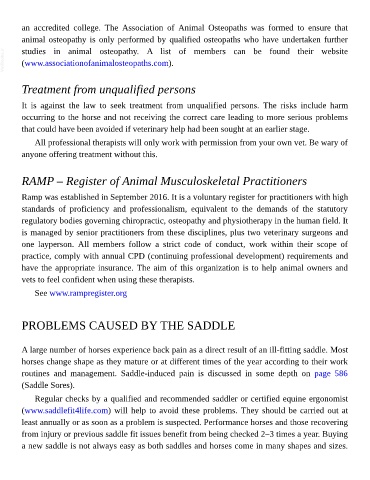Page 547 - The Veterinary Care of the Horse
P. 547
an accredited college. The Association of Animal Osteopaths was formed to ensure that
animal osteopathy is only performed by qualified osteopaths who have undertaken further
VetBooks.ir studies in animal osteopathy. A list of members can be found their website
(www.associationofanimalosteopaths.com).
Treatment from unqualified persons
It is against the law to seek treatment from unqualified persons. The risks include harm
occurring to the horse and not receiving the correct care leading to more serious problems
that could have been avoided if veterinary help had been sought at an earlier stage.
All professional therapists will only work with permission from your own vet. Be wary of
anyone offering treatment without this.
RAMP – Register of Animal Musculoskeletal Practitioners
Ramp was established in September 2016. It is a voluntary register for practitioners with high
standards of proficiency and professionalism, equivalent to the demands of the statutory
regulatory bodies governing chiropractic, osteopathy and physiotherapy in the human field. It
is managed by senior practitioners from these disciplines, plus two veterinary surgeons and
one layperson. All members follow a strict code of conduct, work within their scope of
practice, comply with annual CPD (continuing professional development) requirements and
have the appropriate insurance. The aim of this organization is to help animal owners and
vets to feel confident when using these therapists.
See www.rampregister.org
PROBLEMS CAUSED BY THE SADDLE
A large number of horses experience back pain as a direct result of an ill-fitting saddle. Most
horses change shape as they mature or at different times of the year according to their work
routines and management. Saddle-induced pain is discussed in some depth on page 586
(Saddle Sores).
Regular checks by a qualified and recommended saddler or certified equine ergonomist
(www.saddlefit4life.com) will help to avoid these problems. They should be carried out at
least annually or as soon as a problem is suspected. Performance horses and those recovering
from injury or previous saddle fit issues benefit from being checked 2–3 times a year. Buying
a new saddle is not always easy as both saddles and horses come in many shapes and sizes.

